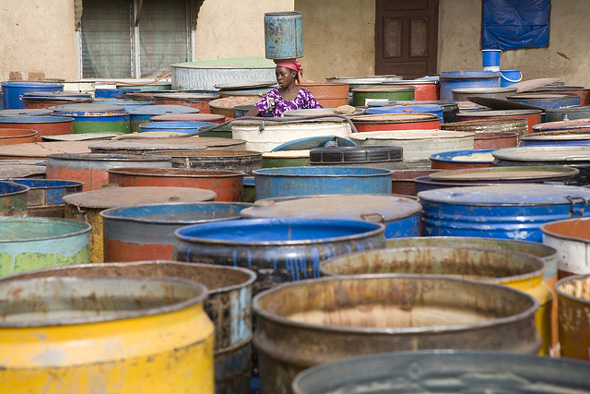-
Linking Biodiversity and WASH Efforts in Africa
November 2, 2012 By Carolyn Lamere
Sub-Saharan Africa is a key region both for conservationists and those working for improved public health. Nine of the world’s 34 biodiversity hotspots are in sub-Saharan Africa, as are two of the five most important wilderness areas. This hotbed of biodiversity is also home to many of the world’s most rapidly growing populations and swelling urbanization, which is putting increased pressure on natural resources.
David Bonnardeaux examines the intersection of these factors in a new report, Linking Biodiversity Conservation, Water, Sanitation, and Hygiene. He was joined at the Wilson Center by Bruno Rajaspera of Conservation International and Dennis Warner of Catholic Relief Services to launch the report on September 10.
Integration on the Ground
Less than 60 percent of the population of sub-Saharan Africa has access to improved drinking water, and only one third has access to basic sanitation. “While there have been noticeable improvements in access to improved water sources in the region, the population growth rate is fast outpacing these efforts,” Bonnardeaux writes in the report.
Bonnardeaux suggests that development projects that connect conservation and water, sanitation, and hygiene (WASH) goals are a natural intersection of interests and can be more effective than single sector efforts.
“Water, poverty, and environment are intrinsically connected,” writes Bonnardeaux in the report, and integrated solutions can help manage the freshwater ecosystems people depend on, improving outcomes for conservation, water, and sanitation simultaneously and more cost effectively than individual solutions.
While he highlights several case studies of programs that integrate WASH and biodiversity conservation, including in Madagascar, Tanzania, South Africa, Gambia, and Senegal, Bonnardeaux emphasized that the report was not just about specific examples. Instead, he hoped to highlight commonalities of successful programs.
He found that health programs often have more immediate benefits to community members than those focusing solely on conservation. Joint programs, therefore, can create greater community buy-in, which is vital for environmental preservation. He also encouraged collaborative programs to hire more general staff who can serve both WASH and conservation interests, as too many specialists can keep each sector segregated from the other.
While a number of primarily conservation programs have begun to integrate WASH elements, Bonnardeaux noted that fewer primarily WASH programs consider the ecological impacts of their activities. To combat this trend, he called on the conservation community to issue guidelines to help other organizations incorporate environmental aspects into their programs.
Case Study: Madagascar
Bruno Rajaspera discussed one of the case studies in greater detail: Madagascar’s Rural Access to New Opportunities for Health and Water Resource Management Project, or RANON’ALA. The 16-month program operated in rural communities in the Makira forest corridor in northeastern Madagascar, and was designed to improve access to family planning and WASH indicators while preserving biodiversity.
The most important aspect of the program was communication, said Rajaspera. RANON’ALA is a collaboration of local and international organizations and has hosted a total of 3,437 public awareness sessions so far, of which 1,354 were dedicated to WASH topics. They have created an easily understood slogan for the campaign that helps spread the message: “healthy water, healthy forest, healthy family.” Rajspera said the program also relies on community members, including local leaders and peer health educators, who were already influential in the community.
These strategies increase community buy-in making the work of community health workers more effective.
Rajaspera concluded that the integrated interventions, with water at the center, are vital to conservation efforts. By providing more tangible and obvious benefits to community members, RANON’ALA helps lead to greater understanding and ownership of the program than a project dedicated solely to conservation.
Response from the WASH Community
Dennis Warner responded to Bonnardeaux’s report from the perspective of the WASH community. The major dilemma holding back linking the two fields, he said, is the reluctance of organizations to engage in topics outside their fields of expertise for fear of being wrong. But he emphasized the necessity of cooperation, despite its difficulties, especially in a vital field like water.
Warner noted that WASH organizations do stand to benefit from incorporating conservation into their projects. Conservation efforts can make the ecosystems people live in more sustainable, which helps preserve both water resources and people’s livelihoods.
Some of the approaches highlighted in the report have great potential, said Warner, including those not previously utilized by WASH programs. While Warner said strategies like community-led total sanitation and integrated water resource management are well known and often implemented by WASH organizations, he was especially impressed by environmental flow assessments, which are a method of measuring and preserving natural water flow as much as possible.
Like Bonnardeaux, Warner said that guidelines would help further integrate conservation priorities into WASH programs. Consideration of environmental factors should be more important to WASH programs, he said, which tend to focus more on the sustainability of physical infrastructure, like pumps, and less on their impact and role within regional ecosystems.
The report and ongoing work on the ground shows that integrating WASH and conservation activities can be fruitful and cost-effective. Although integration may at first be challenging, guidelines and communication strategies can smooth the transition and help lead to more sustainable and effective development in the long term.
Event Resources:
Sources: Community-Led Total Sanitation, Linking Biodiversity Conservation, Water, Sanitation, and Hygiene, United Nations Department of Economic and Social Affairs.
Photo Credit: “The need for safe water,” courtesy of the Bill and Melinda Gates Foundation.
 A Publication of the Stimson Center.
A Publication of the Stimson Center.



